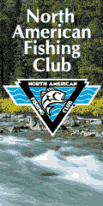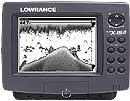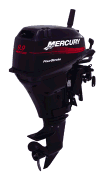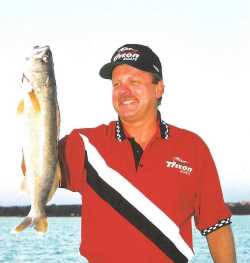 












Promotional
Team Favorites
Lodging food and more









|
Open Spaces, Happy Faces
------------------------
By JOHN KOLINSKI
Editor's note: John Kolinski is the Professional Walleye Trail's 2002
Angler
of the Year and a 12-time championship qualifier during eight years
as a pro
angler on the PWT, RCL and Masters Walleye Circuits. His articles can
be read in many Midwestern outdoor publications and at several web sites.
Kolinski is sponsored by Triton Boats, Mercury Motors, Lowrance Electronics,
Normark/Storm Lures, MinnKota, Lindy Legendary Tackle, Flambeau,
Tempress Rod Holders, Off-Shore Planer Boards, Berkley Trilene, Optima
Batteries, and Panther.
It's late summer, it's hot and the local walleye bite has become as
tough as
a sun-baked leech.It's time to take a break from those small, limited
bodies of water and think big. That's big as in lakes the size of states
and that's big as in walleyes the size of paddles.
Not coincidentally, the two go together like spinners and crawlers.
From Lake
Erie and Saginaw Bay to Green Bay and the Bays de Noc, there are dozens
of
destinations where the fishing can be exceptional and the fish of a
lifetime
more than a remote possibility. And best of all, it can be done from
the relatively small boats many of use on our local lakes and rivers. You
don't need a boat the size of the Queen Mary to safely navigate big water.
Nor do you need major modifications or equipment upgrades to fool the fish
that live there. Hundreds of anglers in boats ranging from 16 to 20 feet
catch hundreds of walleyes and other species from lakes where they
often can't see shore.
That's not to say anyone should ever play "chicken" with big water.
Respect
is healthy, and safety should always come first. There is no risk worth
taking.
A safe outing on big water begins at the boat landing or with a visit
to the
local Coast Guard station for a free safety inspection. Most of us
already
have what is required -- PFDs, fire extinguishers, a horn or whistle,
bow and
stern navigational lights and visual distress signals such as flares
and flags.
Some additional safety equipment isn't required by law, but is strongly
recommended. Foremost is a marine radio, which can save lives in the
event of an emergency while also providing up-to-the-minute weather information.
For navigational purposes, it's wise to carry a compass and a global
positioning unit. If the GPS fails, the compass can help you find your
way back to shore in the event of reduced visibility.
Other items that can prove invaluable include a medical kit, blanket,
bottled
water, snacks, extra motor oil, a tool kit and an anchor with at least
100
feet of rope. Now you are ready to consider whether or not to venture
out, and how far you can go. First, choose the landing that is closest
to the area you intend to fish. Sometimes, a 30-mile drive is rewarded
with a fishing spot that's out of the wind. Second, check the local marine
weather forecast, which is available on your marine radio 24 hours a day.
If thunderstorms are imminent, stay on shore and wait until they pass.
If they are forecast for later in the day, choose a fishing spot from which
you can quickly return to the boat ramp or a safe harbor.
Sometimes, storms appear with little warning. Don't dally. One advantage
of
big water is that you can usually see them coming from a considerable
distance
and outrun them to shore. When possible, fish with at least one other
boat or in a group of boats in case you need assistance or the weather
takes an unexpected turn. Fishing on big water nearly always involves navigating
in waves to some degree.
Light winds tend to produce rolling waves that aren't much of a problem
when
going with them at moderate speeds. As the waves grow larger,
the trick is to increase the boat's speed while ascending the crest of
the wave, then back off the throttle while descending the other side. Trim
the motor up a little to keep the bow high enough to avoid spearing a wave
on the downside.
Going against the waves is more dangerous. It requires the same speed
adjustments, and it helps to take them at an angle so the driver can
see what's
coming. If you must turn, be sure to do so on the way down a wave rather
than the way up.
If the waves keep getting larger or more violent, parallel them even
more and
criss-cross your way back. It will take more time, but it will be far
safer.
And if you don't think you can make it back to your point of origin,
it never
hurts to consider finding a safe harbor somewhere else until the weather
blows
over.In all cases, avoid shallow water. Waves are always more violent
in shallow water than deep water. Remember that six-foot waves over a six-foot
reef mean there won't be any water left at the bottom of the wave. That's
when boats get beached and swamped and lives are put in danger. Even when
returning to harbor, slowing down suddenly can result in waves coming over
the back of the boat.
Safety should be part of your fishing game plan, too. When it's bumpy
on the
water, it's a good idea to designate a fish-fighting seat rather than
having
multiple people moving around the boat trying to maintain their balance.
A long-handled net is a wise investment. The less time the net person
spends
hanging over the back or side of the boat in waves, the better. Get
the fish
in the boat as quickly as possible.
With a little luck, your primary concerns on the water will be how
to go
about catching a few trophy walleyes.
Shallow-water bites can be found when the wind blows and the water
stains,
but walleyes are more likely to gang up around deep-water reefs and
humps that come up to 20 or 30 feet and extended shoals that attract baitfish.
When structure isn't an option, temperature breaks in the water column
can
attract baitfish and, in turn, walleyes to certain areas that are basically
in
the middle of nowhere.

Lowrance’s
new X-15 |
Quality electronics, like the Lowrance X-19 unit, show not only baitfish
and the predators around them, but will actually show temperature changes
because of the density variations they cause in the water. The presence
of other boats can be your best locator. Schools of late-summer walleyes
can be huge, and local anglers and charter captains tend to know where
they are. |
If it's in your budget, hire a charter captain for a half-day or day to
get a
better idea about location, presentations and color patterns. Once
you find them, the emphasis is on making a subtle presentation. Big water
tends to be clear water as the summer wears on, and the biggest fish in
an area are always the spookiest.
A quiet kicker motor like my Mercury 9.9 h.p.
four-stroke is one of several advantages an angler can employ.Two primary
presentations come into play -- stickbaits and spinner rigs tipped with
crawlers. Both work well at times and both can be fished at virtually
any depth. Since these walleyes are usually feeding on forage above
them in the water column, make sure your baits pass over and not under
them.I like to use a pair of manual downriggers to help locate the most
active
fish. After experimenting with shorter leads, I've settled on
long leaders of 150 feet or so behind them. It does make a difference. |

Mercury
9.9 h.p |
By adding stackers to the downrigger cables, you can run multiple
lines at
different depths off the same downrigger. One advantage of downriggers
is that
you can see on your electronics exactly where the cannonballs are running
in
the water column and make quick adjustments when fish appear at different
depths. When I determine the depth for the day, I use other means to get
additional baits into the strike zone. Luhr Jensen's Dipsey Divers are
a great way to take a lure out away from the boat and down in the water
column. As with the downriggers, I prefer long leads. I use a 30- to 35-foot
section of 17- to 20-pound Berkley Trilene as a leader and 10-foot Abu
Garcia Workhorse rods that have the backbone to stand up to the torque
that comes with trolling Dipseys.
 |
When I get fish a fish on, I reel the Dipsey up close to the rod tip,
then hand-line the fish the rest of the way.Other options include snap
weights, keel sinkers or segmented lead-core line
when the fish aren't too deep and weights of more than four or five
ounces aren't required. Line-counter reels help the angler duplicate effective
combinations.
These presentations are used in conjuction with Off-Shore planer boards
which are another way to get lures out away from the boat. |
Light-biting fish can be a fact of life by July and August. Many times,
I've
had them grab hold of the lure and just swim along with the boat. The
only way
I've been able to detect them is from a slightly different angle on
one of my
downrigger cables.
Sometimes, you can entice more aggressive bites by speeding up. That
might
mean changing crankbait styles or going to a willow-leaf spinner rig
rather than
an Indiana or Colorado style of blade. Or, it might mean shifting the
kicker
into neutral now and then and letting crankbaits suspend or spinner
rigs
flutter a few feet. When the waves get big, I like to shut down the
kicker and let the wind carry me silently along. If necessary, I'll use
a drift sock to slow down the boat. In these situations, dead rods can
be used effectively in combination with downriggers and dipseys.
Some of the most memorable days I've had fishing for walleyes have
occurred
on the Great Lakes. I'm talking about big numbers of big fish. If you
haven't
ventured into the wide-open spaces, give it a try. Chances are, the
fishing
will put a smile on your face.
E-mail
John Kolinski

Fish
Clix Banner Exchange
Walleyes Inc. website is maintained
by Randy
Tyler Fishing the In-Fisherman Professional Walleye Circuit, Masters
Walleye Circuit and the Wal Mart RCL Circuit. All rights reserved.Copyright
1999/2003
Please visit these site sponsors
Daiichi/Tru-Turn Hooks,
Lindy
Little Joe,
R-A.M Mounting Systems,
Ranger
boats, Mercury Outboards,Bedford
Sales , Church Tackle, Panther
Marine Products,
Webfoots body sock,
Bait
Rigs Tackle ,Dual Pro Charging Systems,
Daiwa
Rods and Reels,
Driftcontrol
Wind socks,
Trojan Batteries
|




